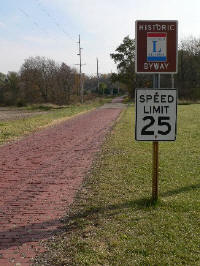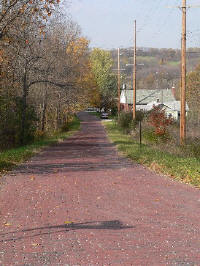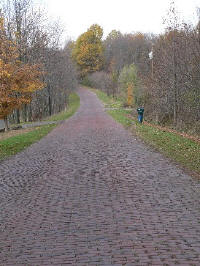
BUCKEYE RAMBLINGS
The Official Newsletter of the Ohio Lincoln Highway League
Number 54
November, 2007
TOWNSHIP TRUSTEES MAKING PLANS TO PAVE OVER LINCOLN HIGHWAY BRICKS
As reported by Ed Balint in a fine story that was published in the October 7 edition of The Canton Repository, Osnaburg Township Trustees and Paris Township Trustees are once again considering the placement of blacktop over two landmark brick roadways in Stark County, Ohio. This would include the entire half-mile brick road remnant known as Cindell Street in Osnaburg Township, and much of the two-mile stretch of alternating brick and blacktop known as Baywood Street in Paris Township. The two roadways were on the main line of the coast-to-coast Lincoln Highway from 1913 to about 1935, but became remnants of the historic route when a new two-lane version of U.S. 30 was carved through eastern Stark County.
Members of the Eastern Ohio Chapter are diligently working with local officials to find some means to preserve these landmarks, which are becoming as rare and as treasured among highway enthusiasts as the original wagon ruts on the Oregon Trail. It is hoped that Transportation Enhancement Funds can be used to save the two roadways, given that one of the criteria for the use of those funds is historical in nature. Over the 241-mile course of the Lincoln Highway Historic Byway across Ohio, only two other brick road remnants can be found within parts of a public right-of-way—Sylvan Road in Wooster and Old Lincoln Highway near downtown Upper Sandusky, the latter of which is the location of an Ohio Historical Society/Ohio Bicentennial Commission marker that was erected in October 2001. Windsor Road in Richland County, which is marked with a logo sign and lovingly cared for and cleaned by the Mid-Ohio Chapter, includes a brick remnant that predates the 1928 route. However, in terms of overall length and scenic quality, none of these three remnants compare to the two remnants in Stark County.
Unless funding is found to preserve the brick road remnant known as Cindell Street, Osnaburg Township Trustees may place blacktop over the bricks as soon as 2008. Thus, readers are requested to send letters to those township officials as soon as possible to show your support for the efforts of the Eastern Ohio Chapter. A sample letter will be mailed along with this newsletter, which readers can either sign then mail, or use as a model for an original letter. An electronic copy of the letter in the format of Microsoft Word can also be requested by contacting the editor at: mgbuettner@kohlikaliher.com.
|
(Below) November 2007 pictures of Cindell Street [left and middle] and Baywood Street [right]. Click to expand. |
||
 |
 |
 |
NEW SECTION OF U.S. 30 NOW OPEN
Entirety of November 9, 2007 Press Release from Ohio Department of Transportation, District One (Lima)
A new section of U.S. 30 between Ohio 235 and the Upper Sandusky bypass was opened to traffic today, said Tim Burkepile, Ohio Department of Transportation District One Deputy Director. Barricades throughout the corridor were systematically removed beginning at 8 a.m. and the operation was completed by 11:15 a.m., he said. “There were no problems encountered during the opening. It was a smooth transition and the operation went as planned,” said Burkepile. Former two-lane U.S. 30, which is now known as County Highway 330 [Wyandot County], is now closed at County Highway 103 west of Upper Sandusky to allow construction to continue on a small section of four-lane pavement. Traffic is one lane in each direction through the work zone which is approximately a half mile in length. Construction of the pavement, which will make the final connection to the new westbound lanes, is expected to be completed by the end of the year. Construction also continues on the interchange at County Highway 330 which is expected to be completed next summer. County Highway 330 remains closed.
RESEARCH DISCOVERIES ON THE SUBJECT OF BRICK ROADWAYS
In 1938, the Ohio Department of Highways (ODH) prepared a Board of Inquiry Report in response to harsh newspaper criticism of department policies. The editor came upon this publication while on a research trip to the Transportation Library at the ODOT Central Office (ODOT [Ohio Department of Transportation] is the modern equivalent of ODH). Among the criticized practices was the use of bricks for highway paving work. After a study of the matter, the inquiry board prepared a table which compared the costs for constructing similar lengths and widths of roadways made of brick and concrete. According to this table, the cost per mile of a 20-foot wide brick road was $43,268. This included costs for the concrete base, the concrete curb, and the 3-inch brick surface (18 feet and 8 inches from face of curb to face of curb). By comparison, the cost per mile of a 20-foot wide reinforced concrete road was $21,745. These numbers would increase to $61,920 and $40,471, respectively, if adjustments were made for the same amount of roadway grading, drainage, structures and roadway improvements as was done on the concrete road projects of 1936. Although the brick roadway was significantly more expensive to construct, the ODH defended their use of the material because it was not only supporting Ohio industries, but it was also sustaining employment for Ohioans who were still recovering from the Depression years. No mention is made of the comparative expenses of future maintenance, which would almost certainly have favored the brick roadway. For example, it was reported that a brick street in Steubenville had not cost the city one dollar from 1884 to 1910 (see sheet 3).
The Board of Inquiry Report went on to say that “Ohio is considered the center of the brick paving industry in the United States,” with half of the nation’s paving brick manufacturing being done in Ohio. In 1936, the total mileage of vitreous brick pavements in the United States was 2812 miles on primary systems of rural highways. Ohio had 51 percent of that mileage with a total of 1436 miles. This was up significantly from the 231 miles of brick roads that were tallied in a 1910 report by the Ohio Highway Commissioner.
OTHER ODDS AND ENDS OF INTEREST
In 1925, the Ohio Department of Highways began erecting white crosses at the sites of fatal accidents, with one cross per each fatality. Although intended as a program to draw attention to safety, the public sentiment turned negative after a few years and the scheme was abandoned. In those few years, a total of 2081 crosses were erected at the following locations: 684 on straight roads, 667 at railroad crossings, 343 at curves or turns, 122 at crossroads, 115 on hills, 111 on bridges, and 39 on side roads.
A 1910 report by the Ohio Highway Commissioner tallied 231 miles of brick roads in the rural areas of Ohio. By comparison, there were 14,188 miles of gravel roads, 1687 miles of macadam road, and 64,755 of mud roads.
The last tollgate in Ohio (before the Ohio Turnpike) was not abandoned until 1912.
THE PAVING BRICK INDUSTRY IN OHIO
(Excerpts from an article by Steven D. Blankenbeker for the Ohio Department of Natural Resources)
The native rocks and sediments of Ohio have provided raw materials to industry since the earliest pioneers entered the state. Today, many of these same materials, such as coal, clay, limestone, salt, and sand, continue to contribute to the economy. But one industry that used the rich mineral resources of Ohio has nearly faded from the landscape. If not for the durability of the products, the paving brick industry of Ohio would be easily forgotten. Today, however, we can still see lasting reminders of this industry in the streets, alleys, and sidewalks of nearly every town and village in our state.
The paving brick industry flourished in Ohio from the 1880s until the 1930s—fifty years and hundreds of millions of paving bricks. Miles and miles of roads in Ohio and the Midwest were paved with these heavy bricks (also called blocks or pavers). So well suited for this purpose were these bricks that many streets in use today are nearly the same as they were when the bricks were laid nearly 100 years ago.
A paving brick is larger than a conventional building brick—traditionally 9 inches by 4 inches by 4 inches and weighing about 10 pounds. The larger size helped keep the block from being dislodged by a vehicle or weather. Typical traffic of the late 1800s was horse-drawn carriages and pedestrians, so the earliest bricks obviously were made without automobiles in mind. Paving bricks also had to be resistant to weathering. A porous brick would absorb moisture and fail in freezing weather. A porous brick also would be structurally weak and more likely to wear away in high-traffic areas. To create a brick having low porosity and high strength presented the paving brick manufacturer with a difficult task….
Paving brick had to be compacted to a higher density than a pressed firebrick. Paving bricks commonly were extruded to roughly the finished size and then “re-pressed” to square up the brick and further increase the density. Re-pressing allowed the manufacturer to “brand” the brick—impress the company’s name on it. Because nearly all re-pressed pavers were branded, today we can still identify the manufacturer. Re-pressing also allowed the brickmaker to produce either lugs (small knobs at the corners of the face) or raised lettering on the brick. When the bricks were laid, these raised areas kept the bricks spaced apart just enough to allow pitch or sand to be introduced between them to help secure the roadbed. Grooves commonly were added to the back of the bricks for the same purposes. It was much easier to put lugs on a brick than raised lettering, so manufacturers apparently abandoned raised letters after the turn of the century. Thus, a paver that has raised letters is generally an older type. Many companies produced extruded pavers and by-passed the pressing operation. These common pavers generally bear no brand, unless a manufacturer rolled the brand on the edge or end of the brick. There is no way to know the manufacturer of these bricks….
The first bricks used for road surfacing in Ohio were made in Newell, West Virginia…[and] were used to pave a portion of Third Street in Steubenville in 1884. The quality of these bricks was such that, in 1910, Steubenville city officials stated that the bricks had not cost them $1.00 in repairs since they had been laid 26 years earlier.
The first paving bricks manufactured in Ohio were made in Malvern, in Carroll County, in the summer of 1885…A paver from Malvern, called “Blue Granite Rock,” was awarded a medal for its quality in a paving brick competition at the 1893 World’s Columbian Exposition in Chicago. “Granite” was a common term for pavers, inferring that the product was “granitelike” or very hard….
The Canton area in Stark County is adjacent to major outcrops of Clarion shale, which was a good material for pavers. The Pro Football Hall of Fame occupies the site of the old Williams brickyard, and the nearby stadium was built in the old shale pit. Canton would eventually become known as the "paving brick capital of the world"; no fewer than nine plants manufactured pavers in the area. The modern-day Belden Brick Company, which has a number of plants in Tuscarawas County, started out making paving block near Canton as the Canton Brick Company. However, it was the dominance of the Metropolitan Paving Brick Company that was critical to the growth of Canton brickmaking. The company was formed in 1902 by the merger of the Imperial Shale Paving Brick Company and the Royal Brick Company. They soon bought other plants in the area, including some near Cleveland, and eventually had control over most of the paver production in northeastern Ohio. Metropolitan Block can still be seen in streets all over the country. Peak production was in 1923, when Metropolitan shipped 92 million pavers.
WELCOME NEW MEMBERS
Based on the recently received September 2007 roster of the Lincoln Highway Association, there are 124 LHA members with Ohio addresses. This is down only two memberships from 2006, but continues the decline of the past few years. Iowa—as has been the case since the LHA was revived in 1992—continues to have the most memberships with 178, which is up seven from 2006. California (121) has surpassed Illinois (106) for third place among Lincoln Highway states. Other Lincoln Highway states with larger memberships include Indiana (76), Pennsylvania (70), and Nebraska (59). Among non-highway states, Michigan has 29 members, including several kind folks who have membership dues coming to Ohio.
Since the last issue of this newsletter, six memberships have been added to the mailing list of the Ohio Lincoln Highway League (listed alphabetically):
Kenneth Cook (Polk, OH); Charles Hilty (Reston, VA); Andrew Huffine (Minerva, OH); Robert Lamb (Canton, OH); Annette Oxendine (Rowland, NC); and Charles Stone (St. Davids, PA)
UPCOMING EVENTS
MID-OHIO CHAPTER:
For information regarding chapter activities, contact Chapter President Mike McNaull at mmcnaull@hotmail.com or 419-281-3064
EASTERN OHIO CHAPTER:
For information regarding chapter activities, contact Chapter President Jeff Lotze at
fordtractor@att.net or 330-875-2989
OHIO LINCOLN HIGHWAY LEAGUE
April 26, 2008—14th Annual Meeting, to be hosted by Mid-Ohio Chapter. Mike Hocker will be the chairman for this event. Details and location will be announced in the next newsletter.
OHIO LINCOLN HIGHWAY HERITAGE CORRIDOR
August 7-9, 2008CLincoln Highway BuyWay Yard Sale
Thank you to LHA/OLHL member Jim Cassler and The Klingstedt Brothers Company, who have donated the return envelopes that were used to mail this newsletter. Jim and his associates are the official suppliers of Lincoln Highway Merchandise. Members are encouraged to visit the web site at www.LHTP.com for a look at the impressive inventory of items.
Buckeye Ramblings is the newsletter of the Ohio Lincoln Highway League, our state affiliate of the Lincoln Highway Association. Editor of this newsletter and president of the OLHL is Mike Buettner (1618 Chandler Drive/ Lima, Ohio/ 45805). Any changes of address should be forwarded to Mike at his home address, or by contacting his office via e-mail at mgbuettner@kohlikaliher.com or by phone at 419-227-1135. Other officers through April 2008 are Mike McNaull (Ashland), Vice-President; Tammy Buettner (Lima), Secretary; and Michael Lester (Bucyrus), Treasurer. State Director for the Lincoln Highway Association is Marie Malernee (Canton). President of the Lincoln Highway Association is Bob Lichty (Canton). For texts of back issues, plus photography and other Ohio information, visit the web site created and maintained by Jim Ross (North Canton) at www.lincolnhighwayoh.com.
Costs for printing and mailing this newsletter are covered entirely by LHA membership dues. Please renew your membership in the national association so that we can continue to publish news from Ohio on a regular basis.
DID YOU KNOW?
The popular soft drink Seven-Up got its name because (1) it originally came in seven ounce bottles; and (2) the bubbles would rise up in the bottle. Thanks to Gerald Grimes of the Minerva Area Historical Society (and LHA member) for that interesting bit of trivia.